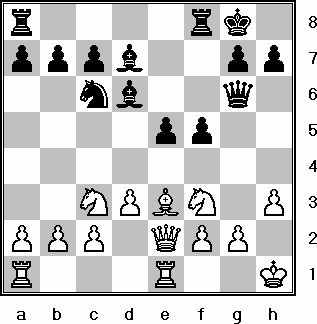|
Lesson
#1
Breaking Through
The Royal Game of chess combines the elements of sport,
science and art. There is much to discover as you explore the world of the
64 squares. And as your chess game grows you may also make discoveries
beyond the 64 squares.
Gradually, you lose pieces to simple combinations less frequently. So
what can make the difference if neither player "hangs" a piece?
Even though the material is equal, perhaps you have some advantage
in: space, time, coordination and safety. How can you build
on this and get a winning game?
The key is often breaking through your opponent�s defenses at a weak
point. Which of your chess pieces is most commonly used for breaking
through? _________________________
The answer is surprising. The lowly pawn is frequently used to break
open and break through. Here is a good example game. You will be playing
Black. White plays the opening passively and we quickly build up a good
position. This game was played over 100 years ago in Budapest.
White: Hermann Black: Rudolf Charousek
Four Knights Game
1. e4 e5 2. Nf3 Nc6 3. Bc4 Nf6
Black is playing the Two Knights Defense. White played methodically and
changed into the Four Knights Game.
4. Nc3
Black now used the "fork trick" to destroy white�s center
and equalize.
4. . . . Nxe4 5. Nxe4 d5 6. Bxd5 Qxd5 7. Nc3 Qd8
Notice that the queen returned home. She does not want to be in the way
of her other pieces. Also, even through the a5 square is safe she would
prefer to be ready to shift over to the kingside.
8. 0-0 Bd6 9. d3 0-0
Black didn�t rush into pinning with Bg4. It looks strong but in chess
often "the threat is stronger than the execution" (Nimzovitch).
In this case we let white worry about Bg4 and try to prevent it. Often
preventing the move is worse than allowing it. As we will see, white falls
into the trap.
10. h3
Now the kingside is weakened and black didn�t spend any moves to
bring it about. So black grabs more of the center.
10. . . . f5 11. Re1 Bd7
Notice how black did not play 11. ... Be6. Can you tell me why not?
____________________________________.
The answer is that the bishop is not guarded on that square. It would
allow white to attack black�s center with 12. Bf4! It is good to put
your pieces on safe squares where they are coordinated with their buddies.
12. Qe2 Qe8 13. Be3 Qg6
White is getting uncomfortable. Do you see black�s threat?
___________________ White defended 13. ... f4 by moving his king.
13. Kh1
|
|

|
Black to move
|
Now let�s take a close look at this
position. Material and development (time) are equal. But black
has more space with his good central pawns and his pieces are more coordinated.
Lastly, many of his pieces are aimed toward the white king, making the white
monarch feel unsafe.
Black has prepared well. He would like to
attack on the kingside. But what should he do next? In cases like this it is
good to ask which white defender is best defending the kingside?
(a) Bishop (b) Knight on f3 (c) Queen
Charousek wanted to remove the knight at f3.
How did he do it? ______________________
13. . . . f4! 15. Bd2 Nd4!
Now we are removing white�s best
defender---the knight on f3.
16. Nxd4 exd4 17. Ne4
The moment of truth has arrived. Can
you find the truly best move in this position to complete the breakthrough
on the king side (remember the lowly pawn): ______________. If you don�t
play it immediately white can block that square.
17. . . . f3! 18. gxf3 Bxh3 19. Rg1 Qh5
20. Rg5 Qh4 21. Kg1
|
|

|
Black to move
|
Black has broken up white�s kingside. But
is there a checkmate? 21. ... Rae8 is very strong but he found better. He
found a most beautiful way to get his bishops further into white�s
position.
21. . . . Bh2+!
If 22. Kxh2 then Bf1+ wins the queen.
22. Kh1 Bf1!
Anyway! Can you work out the checkmate if
white takes the bishop? ___________________.
23. Qd1 Be2!
Black insists, please take my bishop! But
white refused and resigned instead. Can you figure out why? The
solution is 24. Qxe2 Bg3+ 25. Kg2 Qh2+ 26. Kf1 Qh1#.
Breakthroughs in chess and in life can be
exciting and rewarding. They require a good deal preparation though. It may
be that little extra something you do, like using the lowly pawn, that makes
all the difference.
Home Page � More
Lessons
(c) 2001 Ross Stoutenborough
|